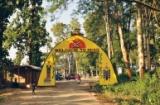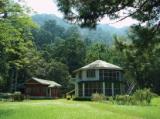Archives
Namdapha
Namdapha is unpredictable, which is why a visit there is an experience of a lifetime. It is a forest that beckons and stays within, its presence not made up of the individual tigers, flowers, butterflies, trees and people but one large pulsating entity that fascinates and charms.
Sharing borders with Myanmar, Namdapha is home to one of the most unusual and most significant wildlife sanctuaries in India. Its vast bio-diversity supports a fabulous range of endangered flora and fauna and avian life. Its altitudinal variation is truly unique, ranging as it does from the sea level of the valley floors, to snow-covered peaks at heights of 4500 m. The climate here ranges from tropical to the extreme cold all year round in its higher reaches.
Gifted with exquisite scenic beauty and a rich store of the rare and unknown, the place is a prime destination for scientific excursion and trekking expeditions.
Located in the mountainous state of Arunachal Pradesh, Namdapha lies at 27o 15‘N and 27o 39‘E and 96o 58‘E longitude in the Changlang district, covering a total area of 245 Sq. Km. It started as a Reserve Forest and was declared a Wildlife Sanctuary in 1972. In 1983, it was declared a National Park and a Tiger Reserve under the Project Tiger scheme. The main tribes that live in the region are the Singphos, Khamptis and the Tangsas.
Namdapha is situated about 135 Kms from Tinsukia (Assam) and the journey from here is an experience on its own.
 Miao is the name of the town at the entrance of the Namdapha Tiger Reserve and another 28 kms by road takes you to the Forest Department-run tourist complex at Deban. The lodge is set on the banks of the majestic River Noa Dehing, a tributary of the Brahmaputra, and early morning walks along the riverbank are a must. The mist rises slowly from the valleys, goaded by the rays of the morning sun, and the hoolock gibbons join in to announce the dawn of a new day in this remote corner of India. The river appears deceptively calm and, indeed, you can feel its power only when you are on a boat or atop an elephant trying to cross the flowing waters.
Miao is the name of the town at the entrance of the Namdapha Tiger Reserve and another 28 kms by road takes you to the Forest Department-run tourist complex at Deban. The lodge is set on the banks of the majestic River Noa Dehing, a tributary of the Brahmaputra, and early morning walks along the riverbank are a must. The mist rises slowly from the valleys, goaded by the rays of the morning sun, and the hoolock gibbons join in to announce the dawn of a new day in this remote corner of India. The river appears deceptively calm and, indeed, you can feel its power only when you are on a boat or atop an elephant trying to cross the flowing waters.
Although Deban has many new experiences to offer, it is the interiors that are even more magical. The Forest Department usually clears a path on the northern banks of the river which takes you through a tour of the Haldibari –Hornbill–Bulbulia-Rani-Jheel–Firmbase areas. There is no habitation inside, so the feeling of immense solitude is overpowering. The forests here are dark and deep, and the trees stand tall peering down on you.
Hornbill is named after the birds that come to roost there in the evenings. Once inside the forest, the only places where you will see a good expanse of sky are at the campsites.
Bulbulia is a hot spring. The area around this bubbling spring is covered by a grey gooey slush that you can smell a kilometer away.
Rani Jheel which is another 4 kms from Bulbulia, is a small pond 800m high on a plateau and surrounded on all sides by forest. It is thought to be an ideal place for the rare white-winged wood duck.
Through the travel, one comes across such memorable destinations like a part of the Stilwell Road, a true reflection of human courage and will power, the Memorial Graveyard, reminding us of the days of the China War. The Tibetan Institute of Handicrafts, a shelter for Tibetan refugees, famous for its carpet industry, the Miao Bio-Diversity Musuem, where one can get a glimpse of the diverse ecological life of Namdapha, a ropeway from Mao to Pho villages of Adis and Khamptis for the adventure freaks, who can test their nerves to the very edges.
 Namdapha falls at the junction of the Indian sub-continent and has extensive diversity of flora and fauna. The biomes recognized in this region are Evergreen forest, Moist Deciduous forest, sub-Tropical forest, Temperate from Deciduous forest, sub- tropical forest. From Nagaland and upper Assam walking through the forest one is forced to believe that Namdapha is a botanist‘s paradise. Every plant is unique and distinct from the other.
Namdapha falls at the junction of the Indian sub-continent and has extensive diversity of flora and fauna. The biomes recognized in this region are Evergreen forest, Moist Deciduous forest, sub-Tropical forest, Temperate from Deciduous forest, sub- tropical forest. From Nagaland and upper Assam walking through the forest one is forced to believe that Namdapha is a botanist‘s paradise. Every plant is unique and distinct from the other.
For the truly dedicated wilderness and wildlife fan, a visit to the Namdapha National Park is challenging, covering a wide range of altitudes from 200 mtrs to 4,500 mtrs. The park, largely inaccessible, has diverse habitats and flora and fauna that are typical of this area. The majestic gaur or mithun, elephant, Himalayan black bear, takin, the wild goat peculiar to the Patkoi range, musk deer, slow loris, binturong and the red panda are all found here. Predators include the tiger, leopard, the rare snow leopard and clouded leopard in the higher reaches of the hills. The white winged wood duck a rare and endangered species has been shelter in the park. A number if primate species are seen in the park such as the Assamese macaque,pig-tailed macaque and the distinctive hoolock gibbon, Hornbills. Jungle fowls and pheasants flap their way through the jungle which harbors other colourful bird species. The inaccessibility of the greater part of the park has helped to keep the forests in their pristine state.
|
Common Animals found in the region Gaur, ghoral, takin, musk deer, hoolock gibbon, slow loris, biturong, red panda, tiger, leopard, snow leopard, clouded leopard and many more mammals and reptiles Common Birds found in the region Over 500 different species of birds exist in this national park. When to visit During the period, October to April. Tourist Attractions Journey to Namdapha National Park in Arunachal Pradesh Getting There By Air: The nearest point of entry via air is the airport at Dibrugarh, Assam. By Rail: The rail station is situated at Tinsukia in Assam. By Road: From Tinusukia or Dibugarh, the journey to Miao, headquarters of the National Park and the Tiger Reserve has to be done by road over a distance of 150 kms. Then, a forest road stretching over around 28 kms gives access to the protected area up to a place called Deban, which has a lovely forest rest house and some other accommodation for the field staff. Beyond this area there is no road as such and all movement inside the reserve has to be on foot through dense forest and steep hill ranges with streams and rivers flowing in between. Miao can be reached by Jeep/Gypsy from Margherita (Assam) and Pasighat. |
Namdapha is truly magical and each time you leave the park, you are to leave with a part of the place within you. Such an unfettered wilderness is not found anywhere else.
